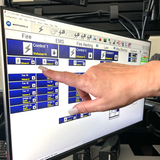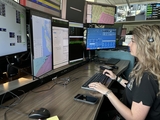You want a memorable 911 call?
John Garcia, a 911 dispatcher, doesn’t want to talk about shootings or car wrecks or house fires or heart attacks. “That’s how you don’t get invited back to parties,” he said.
“I’ll give you one of the more funny calls I’ve had,” Garcia offered. “I had a guy who stabbed himself three times on accident.
“He was making dinner and he was chopping food and he cut the tip of his finger off. What are you always taught? Got to put direct pressure on it. So, still holding the knife, puts direct pressure on his finger and stabs himself in the abdomen. He’s like ‘Oh no’ and he lets go of the knife – blade right into the foot.”
This is not to say that Garcia is heartless or finds humor in the suffering of others. Highlighting the unusual (and injuries that turned out to be minor) is a way to cope with the pressure of being the first person someone calls on what is often one of the worst days of their lives.
Or as he put it, “The stuff you see in the news is real.”
Garcia is one of about 60 people who staff the County’s Department of Public Safety Communications Center around-the-clock. Dispatchers answered 361,249 calls in 2023, about 30,200 a month, from the second floor of the County’s Regional Operations Center in downtown Redwood City.

The logistics of sending the right emergency responders to the right place is complicated in the best of circumstances. In recognition of their collective ability to coordinate so many moving parts, the International Academies of Emergency Dispatch recently recognized them as a “Emergency Medical Dispatch Center of Excellence.”
That means the County’s 911 call center is among 97 centers worldwide that meet or exceed a set of rigorous standards.
To help provide a behind-the-scenes look who answers calls for help, three dispatchers recently spoke about what drew them to the profession, how they cope with the stress and ways callers can help speed response when seconds count.
Veronica Ochoa is 37 years old. She became a dispatcher about five years ago. “Once I found out that it was servicing the community and helping them in one way or another, I was hooked.”
On this day, Ochoa is fielding medical and fire calls, her face lit by the glow of eight (maybe nine; it’s hard to tell) computer screens. Maps. Active incidents. Status updates. A call comes through on her headset.
“County Radio. This is Veronica.”
How does she remain calm?
“That took a while,” Ochoa said. “With my experience in health care, it helped because I worked in cardiology. I dealt with heart transplant patients primarily. We had patients going into full arrest all the time.
“Here, initially, when I got that first 911 call my heart would start racing. I would get super nervous. But I remember my trainer telling me, ‘You’re here at the center. You’re safe. You need to get them help.’ Just remembering nothing is happening to me but making sure they are OK.

“You hear a lot of yelling, a lot of screaming, crying. It’s just remembering I’m OK but they need to be OK and I need to send them help.”
What is a memorable call?
“It was a 5-year-old that went into full arrest and they were at a party. I had a really good caller, though. She was amazing. Someone was giving CPR and I just remember being able to give her instructions. I needed to keep her calm.
“Thankfully the girl was transported and she’s OK. I just felt like if every call could be like that, that would be awesome. People are usually just panicking panicking. Asking repeatedly, ‘Are they almost here? Did you send help?’ This lady really wanted to be instructed and guided so she made the whole process amazing.”
Olivia De Voy is 24 years old and has worked as a dispatcher for about two years. Her journey to Public Safety Communications began at age 15.
“I was a law enforcement Explorer for the Sheriff’s Office Post 810. I joined that while I was in high school because I was interested in learning about law enforcement and I really love volunteering and working with the community,” she said.
After high school, she worked in civilian roles for the Sheriff’s Office until a supervisor suggested she consider dispatch.
On this day, De Voy is fielding calls for and directing law enforcement. This includes the Sheriff’s Office Transit Police Bureau, which at this moment is responding to a fatality along the Caltrain rail line.

“I’ve found I’m just good at compartmentalizing. I don’t know…. Everyone here is really good – if you’ve had a high priority incident, like a shooting, they’ll come up to you, ‘Do you need a break?’ Even if I say no they say, ‘Go walk around the building.’ They want to make sure we’re taking care of ourselves. Our department’s really focused on wellness right now we’re all very much into taking care of each other.”
De Voy was at her console on the afternoon of Monday, Jan. 23, 2023, when she took a call from a survivor of what became the worst mass shooting in San Mateo County’s history. Dispatchers had to quickly piece together what was happening on the ground in Half Moon Bay, at multiple locations, with multiple 911 calls pouring in, with an active shooter on the loose.
“It was just a crazy beehive in here, just making sure we’re documenting all of the information, contacting outside agencies and doing everything we can for the units,” De Voy said, “because they’re taking care of everything on scene.”
This article is part of an occasional series that seeks to help answer the question, “What does government do, actually?”
A memorable call?
“I had a little girl calling 911 repeatedly, kind of playing with the phone but we couldn’t confirm if there was an emergency,” De Voy said. “We didn’t have a good location and she didn’t know where she was so I had her play a game with me because kids love games.
“I said, Ashley, do you want to play a mail game with me? ‘Yeah!’ I’ll give you five points if you can find a piece of mail and you can read me the numbers on it. I was on the phone with her for like 20 minutes. She was OK. She was just playing with the phone.”
(Note: When asked about a memorable call, all three dispatchers provided stories with positive outcomes.)
Garcia, 54, served in the U.S. Air Force reserves as a medic and in civilian life as an emergency medical technician. He moved to dispatching 27 years ago, and today is fielding medical calls.
“Fortunately, I seem to have the right personality type. You can’t be soft spoken. You have to be able to quickly switch between compassionate and not compassionate, depending on what the situation is calling for. We call it caller-management techniques,” he said.
“How do I stay calm? I don’t know. Honest, I don’t know. Sometimes I feel like I do get amped up, hyped up.

“Over time it just becomes something that we do. Something that we learn. I always like to tell people it’s not my emergency. It’s not our emergency. It’s their emergency. And we can’t let their emotions be brought onto us. It’s not fair to them. They’re calling us asking us for help. So we can’t let their emotions affect how we react.”
Sometimes, after major incidents, agencies will come together to provide a debrief, letting those involved learn additional details and what ultimately occurred.
“Typically, we don’t know what the outcomes are,” Garcia said. “We can give someone CPR instructions for two three minutes. We can give CPR instructions for 40 minutes. And we don’t know what happened. Shootings. Stabbings. Domestic violence. We don’t know what the outcome is. Once we hangup, another call comes in.”
Five tips about calling 911:
Call 911 only in emergencies. An emergency is any serious medical problem (chest pain, seizure, bleeding), any type of fire (business, car, building), any life-threatening situation (fights, person with weapons) or to report crimes in progress.
Provide a short description of what’s wrong. “My house is on fire.” “I need an ambulance.”
Provide your address or the location of your emergency. “I can send you everything you need if you know your location,” Garcia said. “If you don’t know where you are, I can’t help you. Work with me. If I’m asking you questions to try to help you figure out where you are, I’m just trying to help you.
“Where are you driving to and where did you start? Then I have something to work with.”
If you call 911 by mistake, stay on the line and tell the dispatcher there is no emergency. Apple Watches and some other ‘smart devices’ are programmed to detect a jarring collision and alert 911 dispatchers. Trouble is, the devices are wrongly calling for help during routine jogging, mountain biking and other activities.
“If you do accidentally dial, just stay on the line. If you don’t, we have to call you back to confirm there is no emergency. If you don’t confirm it, we might send someone out to check on you,” De Voy said.
Answer the dispatcher’s questions. Once a call is answered, the dispatcher will typically ask a series of questions to get you the help you need.
“My biggest advice is listen to the questions that are being asked,” Ochoa said. “All we want to do is to send you help.”
Michelle Durand
Chief Communications Officer
mdurand@smcgov.org
